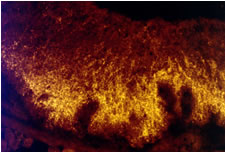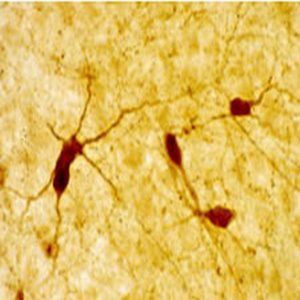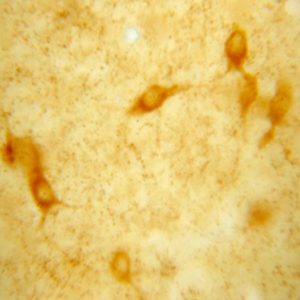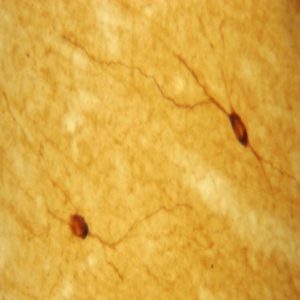Description
The antibody has a proven strong Biotin-Streptavidin/HRP staining at a 1/1000-1/2000 dilution in rat hypothalamus (median eminence). The specificity of the antiserum was examined by soluble pre-adsorption with the peptides in question at a final concentration of 106M.
Somatostatin immunolabeling was completely abolished by pre-adsorption with somatostatin, somatostatin 25, and somatostatin 28. Pre-adsorption with the following peptides resulted in no reduction of immunostaining: substance P, amylin, glucagon, insulin, neuropeptide Y, and VIP.
Photo Description: IHC image of the median eminence staining for somatostatin (above). The tissue was fixed with 4% formaldehyde in phosphate buffer, before being removed and prepared for vibratome sectioning. Floating sections were incubated at RT in 10% goat serum in PBS, before standard IHC procedure. Primary antibody was incubated at 1:5000 for 48 hours, goat anti-rabbit secondary was subsequently added for 1 hour after washing with PBS. Light microscopy staining was achieved with standard biotin-streptavidin/HRP procedure and DAB chromogen. Florescent secondary (below).

Host: Rabbit
Quantity / Volume: 100 µL
State: Lyophilized Whole Serum
Reacts With: Alligator, Anuran (Frog), Bat, Bird, Buffalo (Bubalus Bubalis), Bullfrog, Cat, Chick, Chicken, Dermophis Mexicanus Mexican Caecilian (Amphibian ), Dog, Duck, Fish, Fowl, Frog (Xenopus Laevis), Guinea Pig, Hamster, Human, Lizard, Malayan Pangolin (Sunda Pangolin), Manducta Sexta (Moth), Monkey, Mouse, Pig, Pigeon, Quail, Rabbit, Raccoon, Rana Pipiens (Leopard Frog), Rat, Scorpaena Porcus (Fish), Sea Bass (Fish), Sheep, Snail, Snake, Sparus Aurata (Fish), Starfish, Sting Ray, Turtle, Zebrafish
Availability: In Stock
Preabsorption Control: Available at Sigma Aldrich, Catalog # S9129
Alternate Names: Growth hormone release-inhibiting factor; Somatostatin 14; Somatostatin 28; prepro-somatostatin; SMST; anti-somatostatin
Gene Symbol: SST
RRID: AB_572264
Database Links:
Entrez Gene: 102569049 Alligator
Entrez Gene: 102242181 Bat
Entrez Gene: 100219295 Bird
Entrez Gene: 102394725 Buffalo
Entrez Gene: 101096911 Cat
Entrez Gene: 396279 Chicken
Entrez Gene: 403993 Dog
Entrez Gene: 101800536 Duck
Entrez Gene: 100037904 Frog
Entrez Gene: 100730851 Guinea Pig
Entrez Gene: 100774243 Hamster
Entrez Gene: 6750 Human
Entrez Gene: 708626 Monkey
Entrez Gene: 20604 Mouse
Entrez Gene: 494469 Pig
Entrez Gene: 102092386 Pigeon
Entrez Gene: 107318299 Quail
Entrez Gene: 100353697 Rabbit
Entrez Gene: 24797 Rat
Entrez Gene: 443006 Sheep
Entrez Gene: 102451183 Turtle
Entrez Gene: 79186 Zebrafish




